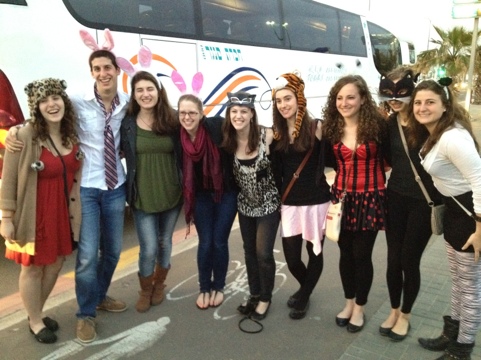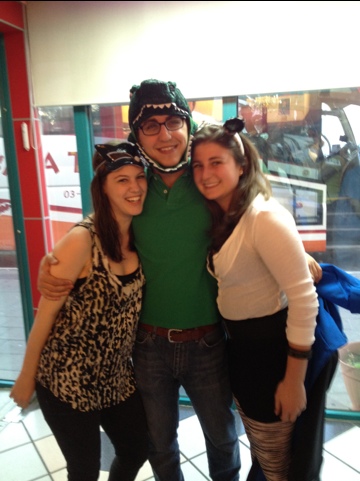Once upon a time, in a land far away (also known as ancient Persia), there lived a king. This king decides that he wants a new wife, and he holds a search and lots of parties in order to find the fairest lady in all of the land. Meanwhile, Esther, a young girl living with her uncle Mordechai, is chosen from the far-off reaches of the nation to compete for his affection. She goes to the palace and her beauty wins the king’s heart.
In my Children’s Theater shows, this would make for a great stopping point. Typical fairy tale rags to riches affair, boy meets girl, boy carries girl into his palace on horseback while the sun is setting. But of course, the fact that I am taking the time to type this from my iPhone in the middle of Tel Aviv means that there is a little more to it than that. This story is not a fairy tale; it is a passage from the Book of Esther, and it is the tale behind the celebration of Purim, a Jewish holiday that I participated in for the first time last night.
In the Book of Esther, there are a few twists. Esther happens to be Jewish (shocker!) but under the recommendation of her uncle, decides to keep her identity hidden from the king. Also, there’s a villain: Haman. Haman is an advisor to the king who is trying to get the king to issue an edict to kill all of the Jews because of his deep hatred for Mordechai. To make a long story short, Esther ends up strategically revealing herself to the king and telling him about Haman’s plan, at which point the king puts a stop to the whole thing, and Purim celebrates the heroism of Esther and the survival of the Jewish people. As someone on my trip said, “Purim has the same theme as every Jewish holiday: someone tried to kill us, and they failed. Then we light candles and drink.”
But drinking is not the only thing we do on Purim (though our group did our best to carry on that tradition); we also dress up in costume to emphasize the discrepancy between what we see in someone’s appearance and their true self. Thus, yesterday in Tel Aviv looked an awful lot like Halloween in America, just with more adults dressed up during the day and more Hamantaschen (delicious cookies in honor of Purim). Exhibit A, though not visible halfway around the world, is my full and contented belly (wine and cookies do wonders for the soul). Exhibit b is below (and for those of you who are wondering, I was a cat. Appropriate, I thought, to help acknowledge the “cat”astrophe that was averted):
Another Purim tradition, and the one that had the deepest impact on me, is audience participation. When the story is read from the Book of Esther, the entire audience (congregation?) participates with loud noises of disapproval whenever Haman appears, approval whenever Esther appears, and other charades for each of the remaining characters. So, the most striking moment of yesterday for me was when one of our tour leaders was up on the bus mic explaining the story to those of us who were unfamiliar, and the entire bus behind me erupted into one long, unsolicited BOOOOOOO! the moment that Haman appeared. The only equivalent I can give (and one that definitely gives away my interfaith upbringing) is when a group of near-strangers starts singing Christmas carols together unprompted; a collection of people with very different backgrounds and very different levels of commitment to their faith spontaneously sharing a tradition. And a very loud tradition, at that. Sitting at a reading last night (and dancing, and eating), I said to a friend, “The only time I hear yelling like this is during the Super Bowl.” (Yes, that’s another hint at my upbringing. Thanks, Dad.)
That could have been the end of our experience of Purim, and it almost was – we were on the bus leaving central Tel Aviv before learning this last fact. But during that ride, one of the Yale rabbis from our trip told us that the story doesn’t actually end the way that it seems from the kids’ services. Yes, Esther persuades the king to change his mind – but rather than reversing the edict, as we had thought, the king says that he is unable to take back an order that he has already given. Instead, he says that he will give advance warning to the Jews of the day that they are supposed to be attacked, so that they can defend themselves, and the story ends with the Jews killing a lot of Persians in order to stay alive.
This ending, though shocking to almost everyone on our bus, no matter how often they had celebrated Purim, felt somehow appropriate in our current setting. Jewish survival – and the survival of the Jewish state – is not always a win-win equation – it seems that there is always one side who must defeat the other in order to continue living their lives, and some kind of extra complication lying beneath what may at first appear to be a fairy tale ending. To be in the right, in Israel, rarely means that the other side is entirely wrong, and there is always a new version of the story to be told.
Chag Sameach (happy Purim) and good morning from Tel Aviv.



Hi Jess, did you ever work on a film project about West Rock public housing in NH? I am not sure if you are the person that I am looking for, but if you are would you please email me – – thanks!
I did! Let me know your email address and how I can help
awesome! well, i would be curious to watch it and get to know more about the research you’ve done about the situation up there. I am making a short documentary about the fence. my email is just in my contact info, let em know if you don’t see it